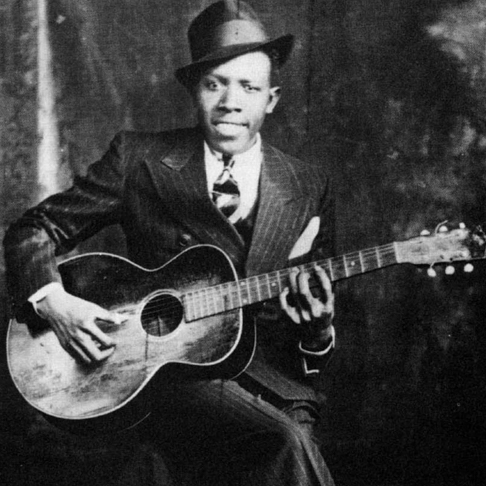Eight decades after his death, he remains one of the most enigmatic artists in popular culture, a brooding troubadour admired by jobbing musicians and global superstars alike. Even people who don’t know his recordings have probably heard the oft-told legend of Robert Johnson selling his soul to the Devil in his quest for fame. If you are looking for a symbol of the spirit of the Delta blues, then this itinerant virtuoso, a hard-drinking, womanizing loner who died in 1938 at the age of 27, fits the bill.
Or so we like to think. Yet a very different picture of him emerges in Brother Robert: Growing Up with Robert Johnson, a memoir by his indomitable 94-year-old stepsister Annye Anderson. Although she was only 12 when Johnson died, the retired educator known to all and sundry as “Mrs Anderson” summons up poignant memories of the young man she so admired. In these pages he is a placid, amiable character who would happily strum popular ditties such as “Pennies from Heaven” in the family home or keep children entertained with one nursery rhyme after another.
The book — co-authored by the Memphis-based journalist Preston Lauterbach — adds more than tantalizing domestic detail; it contains a new photograph as well. Until now, our image of Johnson has rested on two snaps. One shows him genially posing in a studio, wearing a hat and a natty suit and looking every bit the dashing man about town. The other, much more informal shot, was taken in a dime store booth, an unsmiling Johnson holding his guitar, a cigarette dangling from his lip. (When the picture was used on an American postage stamp in 1994, the cigarette was removed by the health-conscious powers-that-be.)

Anderson has come forward with a new picture, which appears to have been taken in the same booth. This time, Johnson is smiling. He looks ridiculously young and carefree. As his stepsister puts it in the book: “It shows Brother Robert the way I remember him — open, kind, and generous. He doesn’t look like the man of all the legends, the man described as a drunkard and a fighter by people who didn’t really know him. This is my Brother Robert.”
We know relatively little about his brief life. His reputation rests on a couple of dozen recordings, a taut summation of the Delta blues tradition made in two sessions in the 18 months or so before his sudden death in Mississippi (he is thought to have been poisoned by the husband of a woman with whom he had been having an affair). None of the discs made an enormous impact during Johnson’s lifetime — his biggest hit, “Terraplane Blues,” sold just 5,000 copies. Yet when Columbia Records released a compilation, King of the Delta Blues Singers, in 1961, Johnson’s reputation suddenly began to take off. That he had spent his career in obscurity only added to his appeal.
One of the young performers who discovered him then was a newcomer to the Greenwich Village folk circuit called Bob Dylan. As he recalled in his autobiography: “The stabbing sounds from the guitar could almost break a window. When Johnson started singing, he seemed like a guy who could have sprung from the head of Zeus in full armour … I copied Johnson’s words down on scraps of paper so I could more closely examine the lyrics and patterns … I didn’t have any of these dreams or thoughts, but I was going to acquire them.”
Across the Atlantic in Britain, a cohort of would-be bluesmen were equally impressed by Johnson’s virtuosity. When Keith Richards of the Rolling Stones first heard Johnson he assumed he was listening to two guitarists playing together. Eric Clapton was a convert too. He wrote later: “It came as something of a shock to me that there could be anything that powerful … Up until the time I was 25, if you didn’t know who Robert Johnson was I wouldn’t talk to you.”
One of the young performers who discovered him then was a newcomer to the Greenwich Village folk circuit called Bob Dylan.
In 1990 a new generation discovered the music when Columbia released the two-CD set The Complete Recordings, including a batch of alternative takes. Remarkably for a blues release, the collection sold by the lorry-load. Sadly, the latter part of Anderson’s book is devoted to her claims that the family was cheated out of royalties by Steve LaVere, a blues researcher and entrepreneur who, it is said, took advantage of Anderson’s late stepsister Carrie (who apparently bought Robert his first guitar) and acquired control of the two famous photographs. LaVere, who died in 2015, became the gatekeeper for the burgeoning Johnson industry and acquired a reputation for zealously protecting his interests.

“I don’t think his energy on behalf of Robert Johnson is in doubt,” Lauterbach explains. “Rather, it’s the way he treated Johnson’s known relatives. He leveraged Johnson’s sister Carrie to gain legal ownership of Johnson’s copyrights. He earned a fair sum. She never received a cent. He also obtained the two well-known photographs of Johnson from Carrie, copyrighted those images, and Carrie never received her share. It’s a story of love and theft.”
Added complications emerged when a previously unknown son of Johnson, Claud Johnson, emerged to claim his inheritance. Much to Anderson’s chagrin, a court ruled in his favor. When I spoke to her by phone last week, she was still talking of her desire to write another book about the legal battle. She is also hoping to market the barbecue sauce that has long been a family speciality. Since finishing Brother Robert, she says, she has recalled many more scenes of those days when Robert was still close to them all. “They’re more about the music and what he played,” she told me. “I mostly remember the religious songs and the family members getting together and singing spirituals and gospel.”
Her book is a tender evocation of a close-knit community where blood ties could be hard to unravel. Keeping track of who is who in the extended family — Robert was illegitimate — is no easy task. To this day, Anderson refuses to acknowledge Claud’s status as Robert’s son. From a musical point of view, perhaps the most valuable aspect of the book is that it reveals how broad Johnson’s tastes were. Blues fans are often purists, and assume that their heroes were too. However, as the distinguished music historian Elijah Wald — who provides the foreword to Brother Robert — points out, Johnson was a sophisticated professional musician whose interests embraced music of all kinds, from popular ditties to jazz. To this day, Anderson talks of their shared love of country music, and in the book we catch glimpses of members of the household enjoying the yodeling of the white country music pioneer Jimmie Rodgers. When the young Annye is planning to enter a talent competition at a local theater, Robert helps her to rehearse an Irving Berlin song, “Let Yourself Go.”
Eric Clapton was a convert too. He wrote later: “Up until the time I was 25, if you didn’t know who Robert Johnson was I wouldn’t talk to you.”
This might come as a shock to some people, but as Wald, himself an accomplished blues guitarist, explains in his excellent book Escaping the Delta: Robert Johnson and the Invention of the Blues, some of our preconceptions about the music come from writers, many of them left-leaning, who saw blues as an untainted folk art rather than a branch of the commercial music of its time. The record industry’s habit of compartmentalizing styles further distorts our vision. Records are a snapshot; they do not necessarily tell us all we need to know about a musician.
There is, as Wald observes, a racial component to all of this. The people who write about blues and attend modern-day blues gigs tend to be white. What they are looking for in the music is not always the same as the Black audiences who listened to this music for pleasure and danced to it as well.
Wald, who is white, insists that a different aesthetic comes into play: “When Mrs Anderson talks about Robert Johnson rehearsing her in her talent show number, it’s a song from the current Fred Astaire and Ginger Rogers movie, Follow the Fleet. It’s very easy for white people to forget this. We tend to think it’s Black people’s job to be hipper than us. But, you know, Black people were buying Herb Alpert in the 1960s right along with Aretha Franklin. One of the effects of a racist system is that Black people get stereotyped, and what we end up knowing about them is the tip of the iceberg.”

If Johnson has become an idealized figure, Anderson’s book helps us to see him as a flesh-and-blood individual, an entertainer rather than some tortured mystic. In a touching scene she recalls the last time she saw him, at a party on the night the family gathered to listen to Joe Louis vanquish his German rival Max Schmeling in their heavyweight title fight in June 1938. She writes of her stepbrother: “You should have seen him in his white sharkskin suit, Panama hat, and patent leather shoes.”
Weeks later came news that he had died while on the road. Among the personal belongings that the family received afterward was a scrap of paper that contained a “deathbed confession”, a brief statement of religious faith that ended with the phrase: “I know that my Redeemer liveth and that He Will call me from the Grave.” Anderson thinks the words were prophetic. “I believe that came true,” she writes. “He’s had a life after death longer than his life on Earth.”


